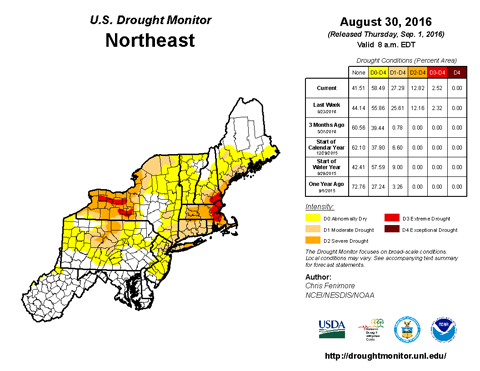Hurricane Hermine Misses Northeast, But Drought Remains
Posted on September 14th, 2016 | No Comments »
By Vincent Caprio
Hurricane Hermine Misses Northeast, But Drought Remains
We survived Hurricane Hermine! Actually, the hurricane did not hit the Northeast. That is the good news. The bad news is the Northeast did not get the needed rainfall. We continue to be in the worst drought in the last 10 years. Last year I said the California drought was coming to your neighborhood … The Drought Comes East: All Water is Local
Summertime in the Northeast is a beautiful season well known for warm weather and backyard barbecues. There is nothing better than grilled fresh corn and local juicy tomatoes bought from your local farm market or produce section of the grocery store. Unfortunately, shoppers have been noticing an increase in prices of their favorite summer produce. This is the first time many people are realizing there is a drought in this country that reaches their own backyard.
I live in a Connecticut town where 20 percent of the area is used for farming. I have the opportunity to eat fresh vegetables and lettuce everyday in the summer. The drought in New England has affected the prices of produce. My favorite fruit is fresh blueberries for my Greek yogurt. Last summer 1 pint was $2.50 – this summer (2016) it is $5.00.
Ask any farmer or gardener in the Northeast and you will hear the same results; this year has been a tough growing season. Between January 1 and June 29 of this year, the average precipitation levels between NYC and Boston, MA have decreased by about five inches. These changes are not going unnoticed. Residents are seeing brown lawns, pollen levels have increased throughout the region, and we are paying higher prices for locally grown produce. Farmers are watching their crop yields diminish with every dry day that passes by and must raise prices to cover the costs of growing. More and more Northeast farmers have been making the expensive upgrade to drip-irrigation systems to further preserve their water supply, which is becoming exceedingly scarce.
What can be done to reverse the damages from this drought that we are seeing in our own backyards? The answers that our children learn in elementary school such as “take shorter showers” and “don’t excessively water your lawn” are helpful, but are only back-end solutions. When we begin utilizing technology to recycle water for agricultural uses in the Northeast as well as on the West Coast, this drought will not be such a burden on our local farms, nor on our produce budgets. It is time to change the way we value water and take advantage of current innovative water technologies. Events such as the Water 2.0 Conferences are addressing these issues.





